 |
October 2016
|
October 2016 // Volume 54 // Number 5 // Tools of the Trade // v54-5tt5
Teaching Record-Keeping Skills to 4-H Youths Through Experiential Learning Techniques
Abstract
Teaching record keeping for breeding projects in a way that keeps youths engaged is a difficult task. The activity discussed in this article was used to teach 4-H participants the importance of record keeping by implementing the experiential learning model and without lecturing. A description of the activity, instructions and materials for the activity, and responses to the activity are presented.
Introduction
4-H sheep breeding projects are designed to expose youths to the skills they need to excel in the field of livestock production. One skill that is essential for successful livestock production is record keeping. And though development of life skills is a foundation of the 4-H program (Boleman, Cummings, & Briers, 2004), teaching record keeping in an engaging, hands-on way without access to live newborn lambs is a challenge. This article describes a 4-H activity that uses the experiential learning model (Jordan & Norman, n.d.) to provide a tactile, fun opportunity for club members to hone their record-keeping skills.
Delivery of the Activity
The taterlamb activity, as it is called, was used to teach 4-H participants in Idaho the importance of record keeping and to give them experience in keeping records for a breeding project. An iteration of the activity is described herein, and all activity instructions and printable materials are provided in the appendix.
The activity began with a brief introduction on record keeping and a discussion about why it is important. Participants brainstormed to identify what information might be important to record when lambing and as lambs grow as well as what records are appropriate for market animal projects. Participants were then organized in groups of three to complete the activity. Younger participants also had an adult helper to aid them.
Each group was given a box containing a set of 10 prepared "taterlambs." The taterlambs varied in size and weight, and each taterlamb displayed the characteristics needed to complete the activity: face color, sex, and ewe number. The use of potatoes in this way took into consideration a preferred delivery method for visual and kinesthetic learners by providing participants with a tactile representation of lamb characteristics (Hawk & Amit, 2007). Potatoes were chosen as a convenient and cost-effective alternative to live or plush animals. Figure 1 shows a sample of the taterlambs as they were being assembled. Note that each taterlamb has one of three different faces, a blue or pink dot (identifying the taterlamb as male or female), and one of five ewe numbers.
Figure 1.
Taterlambs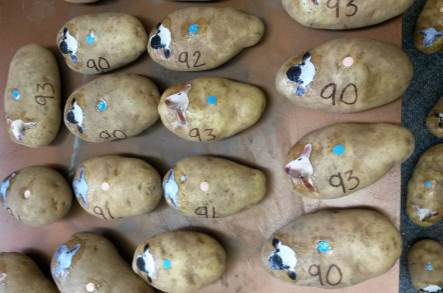
The ewe numbers written on the sides of the taterlambs offered a teachable moment during the activity. Many activity participants did not know that sheep producers write a ewe's number on her lambs to avoid confusion as ewes in the same pen begin to lamb or in case a lamb escapes its enclosure.
In addition to a box of taterlambs, each group was given a worksheet that featured instructions and clues for completing the activity and a table to serve as a record log. The participants were charged with filling out the record log by using their taterlambs and the clues included on the worksheet. The clues were as follows:
- Rancher Ben has five ewes (#89, #90, #91, #92, #93), and three rams (#9, #25, #311)
- Three taterlambs were born last night, and seven more were born this morning.
- Blue dot = male lamb, pink dot = female lamb
- Rancher Ben has painted the lambs' mothers' number on the side of them, to keep track of which lamb goes to which ewe.
- All lambs with black ears and black noses belong to Ram #311.
- Only Ewe #93 was bred to Ram #25.
- Ewe #90 lambed last night
The final step in completing the worksheet was to weigh each taterlamb, using a postage scale provided by the activity presenters, and record its birth weight. Figure 2 shows a record log that has been partially completed with correct information. When the activity is replicated, the birth weight information will vary as potatoes vary in weight. Also, the lambing dates will vary, depending on when the activity is conducted, but should indicate the births of three lambs on the preceding day and seven on the current day. Comments may vary as well.
| Date Lambed | Sire | Dam | Sex of Lamb |
Birth Type (single, twin, triplet) |
Birth Weight | Comments |
| 6-2-14 | 311 | 90 | M | TR | Black lamb face | |
| 6-2-14 | 311 | 90 | M | TR | Black lamb face | |
| 6-2-14 | 311 | 90 | F | TR | Black lamb face | |
| 6-3-14 | 9 | 89 | F | S | White lamb face | |
| 6-3-14 | 25 | 93 | M | TR | Pink lamb face | |
| 6-3-14 | 25 | 93 | M | TR | Pink lamb face | |
| 6-3-14 | 25 | 93 | F | TR | Pink lamb face | |
| 6-3-14 | 311 | 92 | M | S | Black lamb face | |
| 6-3-14 | 9 | 91 | F | TW | White lamb face | |
| 6-3-14 | 9 | 91 | F | TW | White lamb face |
At the end of the activity, all the participants reconvened for a 5-min wrap-up to talk about what they learned.
Conclusion
The taterlamb activity was very well received. All the youths were receptive and engaged and had thoughtful insights during the discussions. Parents and 4-H leaders also praised the activity, requesting the instructions and materials so that they could replicate it with their own clubs. Another Extension educator present suggested adjusting the activity to feature "rocklambs," using rocks as the bases for the faces, dots, and numbers so that they would not decompose, as potatoes do, and could be stored from year to year. Though many of the children who participated did not have any experience in 4-H breeding projects, most were able to complete the activity in the time frame allowed and apply the activity to their current 4-H projects.
References
Boleman, C. T., Cummings, S., & Briers, G. (2004). Parents' perceptions of life skills gained by youth participating in the 4-H beef project. Journal of Extension, 42(5) Article 5RIB6. Available at: https://www.joe.org/joe/2004october/rb6.php
Hawk, T. F. S., & Amit, J. (2007). Using learning style instruments to enhance student learning. Decision Sciences Journal of Innovative Education, 5(1). Retrieved from http://onlinelibrary.wiley.com/doi/10.1111/j.1540-4609.2007.00125.x/full
Jordan, J. C., & Norman, M. N. (n.d.). Using an experiential model in 4-H. Retrieved from http://florida4h.org/clubs/files/101.10_Using_Experiential_Learning_Model.pdf
Appendix
Taterlamb Activity: Instructions and Materials
Compiled By: Meredith Fisher, Adams County, 2014
Activity Instructions
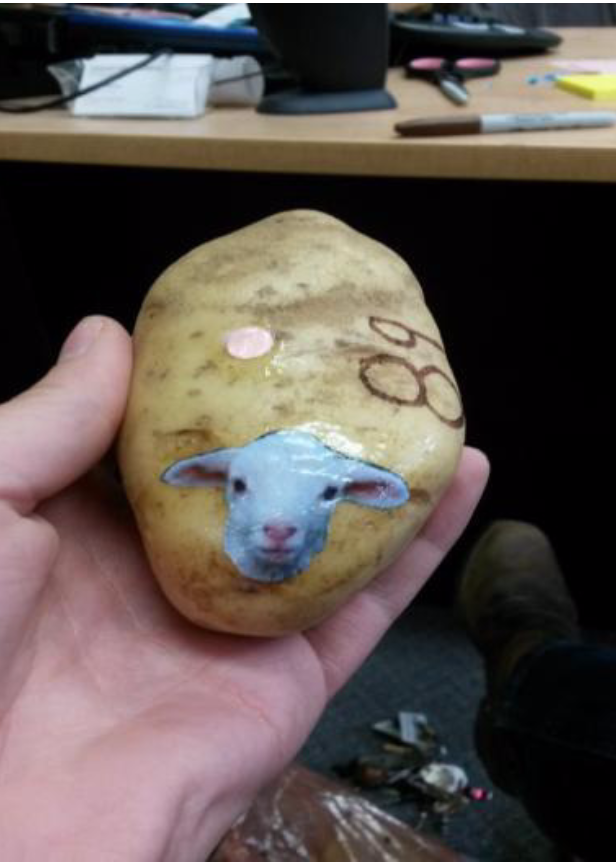
Time:
15–30 minutes
Supply List:
- answer key
- 10 potatoes
- Mod Podge® glue
- lamb faces printout
- pink paper, cut into dots
- blue paper, cut into dots
- permanent marker
- taterlamb worksheet
- kitchen scale/postage scale
Preparation:
Assemble taterlambs. NOTE: Be sure to use the answer key to assemble the lambs. If assembled with random variables, the activity will not work. Glue faces and dots to potatoes using Mod Podge® glue. Write the ewe number on the side in permanent marker. Every lamb should get a face, pink or blue dot, and ewe number.
Print out worksheets.
Activity:
Kids can work alone, in pairs, or in teams. Using the worksheet clues, scale, and their taterlambs, they fill out the lambing record provided on the worksheet.
Discussion Questions:
- What kind of records are you keeping on your project animal?
- Why do you keep records?
- What records do you or your parents keep? Why are these important?
- Why is it important to record in a timely manner (i.e., when the lambs are born?) and not wait until the last minute?
- Scenarios: Stillborn lamb? Would you still record? (Yes, for breeding records.) Jugged/bummer lamb? (Write the info in the comments section.)
Answer Key
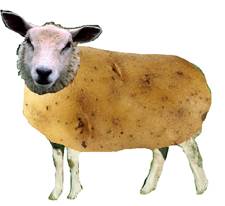
*ANSWER KEY*
Rancher Ben has a new breed of sheep found only in Idaho: the Tatersheep! Use your astute record-keeping skills to fill out the lambing record below.
CLUES:
- Rancher Ben has five ewes (#89, #90, #91, #92, #93), and three rams (#9, #25, #311)
- Three taterlambs were born last night, and seven more were born this morning.
- Blue dot=male lamb, pink dot=female lamb
- Rancher Ben has painted the lambs' mother's number on the side of them, to keep track of which lamb goes to which ewe.
- All lambs with black ears and black noses belong to Ram #311.
- Only Ewe #93 was bred to Ram #25.
- Ewe #90 lambed last night.
| Date Lambed | Sire | Dam | Sex of Lamb |
Birth Type (single, twin, triplet) |
Birth Weight | Comments |
| 6-2-14 | 311 | 90 | M | TR | Black lamb face | |
| 6-2-14 | 311 | 90 | M | TR | Black lamb face | |
| 6-2-14 | 311 | 90 | F | TR | Black lamb face | |
| 6-3-14 | 9 | 89 | F | S | White lamb face | |
| 6-3-14 | 25 | 93 | M | TR | Pink lamb face | |
| 6-3-14 | 25 | 93 | M | TR | Pink lamb face | |
| 6-3-14 | 25 | 93 | F | TR | Pink lamb face | |
| 6-3-14 | 311 | 92 | M | S | Black lamb face | |
| 6-3-14 | 9 | 91 | F | TW | White lamb face | |
| 6-3-14 | 9 | 91 | F | TW | White lamb face |
Lamb Faces (black, pink, white)
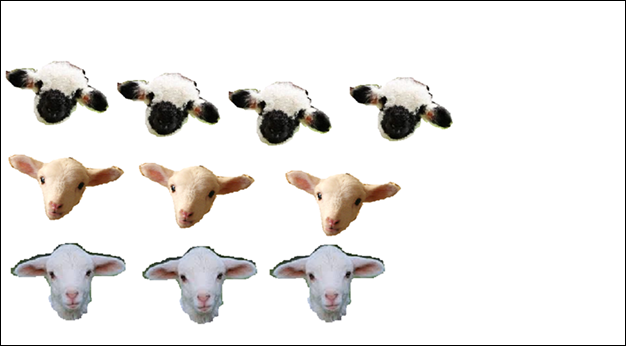
Worksheet
Taterlamb Records
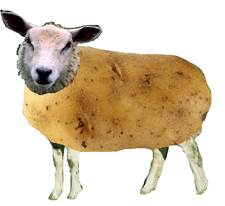
Rancher Ben has a new breed of sheep found only in Idaho: the Tatersheep! Use your astute record-keeping skills to fill out the lambing record below.
CLUES:
- Rancher Ben has five ewes (#89, #90, #91, #92, #93), and three rams (#9, #25, #311)
- Three taterlambs were born last night, and seven more were born this morning.
- Blue dot=male lamb, pink dot=female lamb
- Rancher Ben has painted the lambs' mother's number on the side of them, to keep track of which lamb goes to which ewe.
- All lambs with black ears and black noses belong to Ram #311.
- Only Ewe #93 was bred to Ram #25.
- Ewe #90 lambed last night.
| Date Lambed | Sire | Dam | Sex of Lamb |
Birth Type (single, twin, triplet) |
Birth Weight | Comments |



